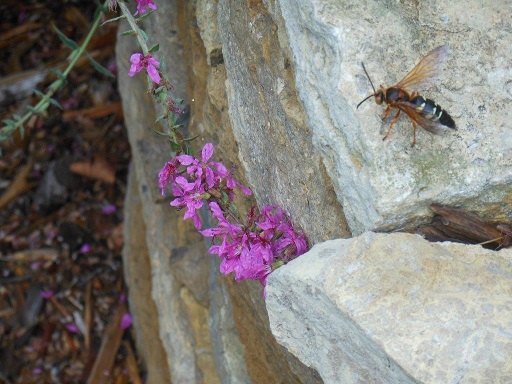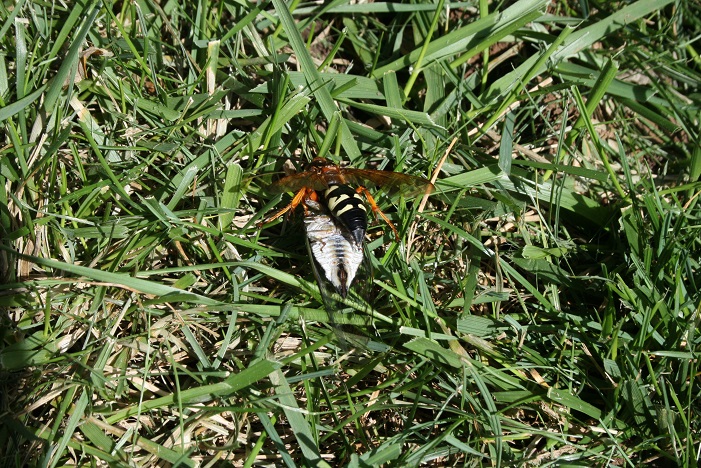–by Dr. Raymond Cloyd
We have received numerous inquiries regarding large wasps flying around. These are the eastern cicada killer, Sphecius speciosus, which is actually a beneficial insect due to regulating dog day cicada (Tibicen pruinosa) populations. The cicada killer hunts and provisions each cell within a nest with a cicada, which becomes the food source for young cicada killers or larvae. Cicada killers are an urban nuisance pest, especially when nesting, sometimes in large numbers, in a bare area or area around a structure. People get concerned because cicada killers resemble giant yellowjackets.
Cicada killers are approximately 2.0 inches in length and black, with yellow-banded markings on the abdomen. The head and transparent wings are reddish brown (Figure 1).
Figure 1: Adult cicada killer (Photo Credit: Daniel Gilrein)
Cicada killers are not dangerous, but they are intimidating. These are ground-nesting solitary wasps, with the female digging a 6 to 10-inch burrow (1/2 inch in diameter) in the ground; usually in sandy or loose soil. A pile of soil or sand, depending on the soil type, typically surrounds the entrance. The female locates and stings a large insect such as a cicada or katydid and then brings the immobilized “prize” back to the burrow (Figure 2).
Figure 2: Adult female cicada killer transporting paralyzed cicada to burrow (Photo Credit: Raymond Cloyd)
burrow (Figure 2).
The female then places the paralyzed insect into a chamber and lays an egg on the body of the paralyzed insect; sometimes the female places two paralyzed insects in a burrow but lays an egg on only one. The female cicada killer eventually covers the burrow, digs another, and repeats the process. The egg hatches into legless grub-like larva that consumes the paralyzed insect. Full-grown larvae overwinter in the burrow, pupate in the spring, and emerge as an adult during the summer (July and August).
Male cicada killers establish aerial territories and patrol for intruders. A male cicada killer wards off other males that enter his territory and attempt to mate with females. Anyone else, such as a human, walking into the territory is typically confronted by a very large wasp that hovers in front of the face and “zips” to the side and back. However, after determining that the “intruder” is not a rival, the male cicada killer ignores the individual. However, as a person walks across a lawn, fairway, or other area where these wasps are nesting, the process is repeated through each male’s territory. Cicada killers are unlikely to sting a person. Wasp and bee stingers are modified egg-laying devices (ovipositors), so males are unable to sting. Females may sting if crushed by being stepped on with bare feet or grabbed with bare hands.
Cicada killers are more common in areas with bare soil, so mulching, planting ground covers, or sodding may reduce potential problems. Cicada killers can also be a problem in well-maintained areas such as irrigated and regularly fertilized turfgrass. They are a major problem when nesting in areas accessible to or frequented by the public. Applying carbaryl (Sevin) or a pyrethroid-based insecticide containing the active ingredient permethrin, bifenthrin, cyfluthrin, and/or lambda-cyhalothrin to the burrowed area should kill females in golf course sand traps. Once the females are gone, males eventually leave. In home yards, sandboxes should be covered with a tarp when not in use since this deters cicada killers. Sand below swings, jungle gyms, or other playground equipment can be replaced with bark mulch or shredded tires.
Managing cicada killers in volleyball courts and baseball infields is more of a challenge because people with minimal clothing and exposed skin are diving and sliding onto the ground, which makes it difficult to recommend using an insecticide on a volleyball court. In these cases, the use of a geotextile fabric placed beneath the sand may create enough of a barrier to prevent cicada killers from creating burrows. The recommendations mentioned above will only be effective if cicada killer populations are not excessive.

